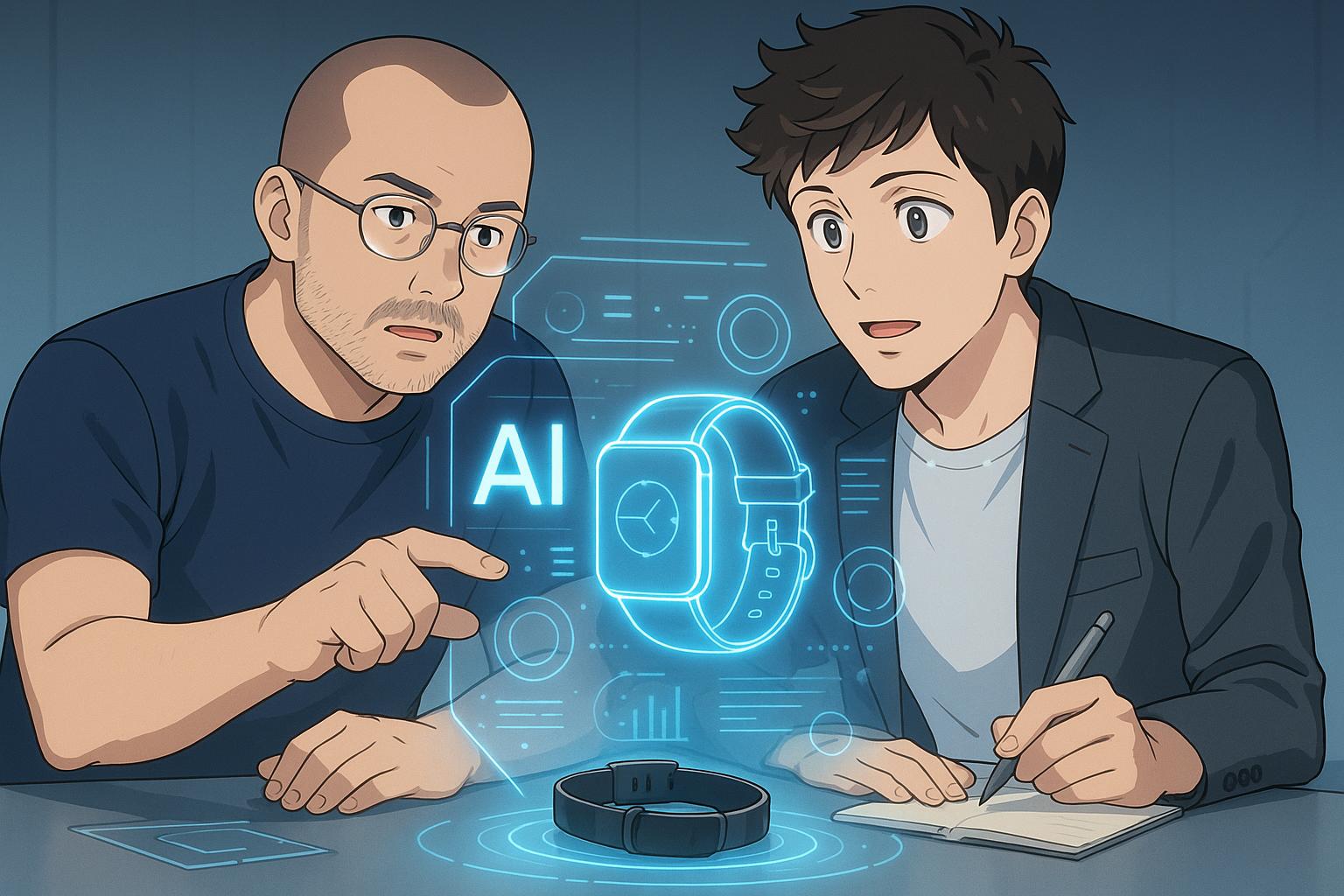Design legend Jony Ive joins forces with OpenAI in a $6.5 billion collaboration to create innovative AI-driven devices poised to redefine user interaction and challenge traditional smartphones and computers.
Jony Ive, the design visionary renowned for creating some of Apple’s most iconic devices, is embarking on a transformative journey in collaboration with OpenAI, marking a potentially seismic shift in the tech landscape. This partnership, rooted in a substantial $6.5 billion deal, aims to establish a new realm of AI-driven devices that could fundamentally alter how users engage with technology, much as the iPhone did in 2007.
The partnership brings together Ive’s acute design sensibilities—honed over 27 years at Apple alongside the late Steve Jobs—and Sam Altman’s ambitious vision for OpenAI. The duo has been quietly working for the past two years, laying the groundwork for innovative consumer hardware intended to replace conventional smartphones and computers. Speculation suggests that this could involve advanced wearables—such as smart headphones, glasses, or a new breed of smartphone—but concrete details remain scarce. Essentially, the aim is to create devices that offer seamless AI interaction without the barriers present in existing technologies.
OpenAI’s investment in hardware signifies a departure from its initial software-centric strategy. It seeks to reduce the friction in AI usage that characterises traditional gadgets. In doing so, the company hopes to carve out a differentiated presence in the tech market that is increasingly driven by the urgent need for effective AI solutions. Although current consumer propositions from OpenAI, such as subscriptions to enhanced ChatGPT models and the DALL-E imaging tool, have generated some revenue, the prospect of hardware could help the company reach its goal of achieving cash-flow positivity by 2029.
The competitive landscape for AI hardware is gaining traction too. Traditional tech giants, including Apple and Google, have struggled to integrate AI into their existing frameworks, with Apple postponing significant advancements in its Siri voice assistant until 2026. In this context, the collaboration between Ive and Altman positions OpenAI as a pioneer, potentially allowing the company to harness a continuous stream of user data to develop an all-encompassing digital ecosystem.
Ive’s departure from Apple in 2019 led him to establish LoveFrom, an agency recognised for its collaborations with prestigious brands like Ferrari and Airbnb. This move to OpenAI marks a strategic pivot back to the tech industry, where his insights and innovative approach could foster a new wave of AI-driven consumer products. The acquisition of his startup Io—now part of OpenAI—brings with it a team of 55 engineers and design experts previously under Ive’s leadership, fundamentally expanding OpenAI’s capabilities.
Despite the promise surrounding this venture, the future product timelines remain uncertain. Altman has indicated that the first hardware collaborations could be unveiled next year, but the collective ambition requires patience and sustained investment in the development process. The partnership hints at a broader industry trend where tech leaders are rethinking device interactions, moving towards solutions that transcend traditional screens and inputs.
As the tech world watches closely, the collaboration between Jony Ive and OpenAI not only has the potential to challenge existing paradigms but also to reshape consumer technology in ways previously considered speculative. While the primary focus remains on innovation and redefining user interactions with AI, one thing is clear: this partnership embodies a pivotal moment that could influence the trajectory of technology for years to come.
Reference Map
- Paragraph 1: Sources 1, 3
- Paragraph 2: Sources 2, 4
- Paragraph 3: Sources 1, 4
- Paragraph 4: Sources 5, 6
- Paragraph 5: Sources 3, 5, 6
- Paragraph 6: Sources 4, 7
- Paragraph 7: Sources 2, 6
Source: Noah Wire Services
- https://www.dailymail.co.uk/yourmoney/article-14740817/iphone-genius-joins-apple-rival-billions-tech-deal-smartphone.html?ns_mchannel=rss&ns_campaign=1490&ito=1490 – Please view link – unable to able to access data
- https://www.theatlantic.com/technology/archive/2025/05/openai-io-jony-ive/682884/?utm_source=apple_news – OpenAI has announced a major strategic shift by partnering with Jony Ive, former Apple design chief, to develop AI-specific hardware that could potentially replace current smartphones and computers. This move, backed by a $5 billion acquisition of Ive’s startup Io, signifies OpenAI CEO Sam Altman’s ambition to remove the friction of using AI tools through conventional devices like laptops and phones. Although details remain vague, the envisioned hardware could encompass wearable AI devices or an ‘external brain’ offering constant ChatGPT-style assistance. Altman and Ive argue that legacy devices inadequately support the evolving use of AI, advocating for a new generation of purpose-built technology. While prior AI devices like Humane’s AI pin have failed, the partnership between Altman and Ive—responsible for industry-shaping products like the iPhone—holds promise. The initiative also seeks to enhance OpenAI’s market presence and reduce its reliance on competitors’ platforms, potentially capturing users’ digital lives into a cohesive ecosystem. This effort reflects a broader trend among tech giants to retrofit AI into existing platforms, often with mixed results. For now, OpenAI is selling its vision with no concrete product revealed, echoing ambitious beginnings reminiscent of Apple’s revolutionary iPhone launch.
- https://www.ft.com/content/60c2143d-1951-4dd2-bedd-744f96faa40f – Jony Ive, the renowned former Apple designer, has joined forces with OpenAI in a landmark $6.4 billion acquisition, positioning him at the forefront of AI innovation. OpenAI acquired full ownership of Ive’s AI hardware start-up io, bringing its 55 employees under its umbrella while Ive assumes a key creative role without becoming a formal employee. The move signals OpenAI CEO Sam Altman’s confidence in Ive’s design vision. This partnership, potentially rivaling Apple, comes as Apple lags in AI development despite a partnership with OpenAI for Siri. Apple’s stock dropped $45 billion following the announcement. Meanwhile, former President Donald Trump is considering an executive order to open 401k retirement plans to private capital investments, a move long sought by private equity firms but met with caution due to concerns about fees, liquidity, and transparency. In corporate activism, Elliott Management won two seats on the board of Phillips 66 after a prolonged campaign, signaling its ongoing influence even amidst a retreat in shareholder activism. Additional updates include several high-profile job appointments at companies like McKinsey, BNP Paribas, and Advent International.
- https://www.axios.com/2025/05/22/openai-hardware-bet-jony-ive – OpenAI is making a major investment in hardware by acquiring the remaining shares of Jony Ive’s design startup, io, for $5 billion in stock. Ive, famous for shaping Apple’s iconic devices like the iPhone, brings with him a team of former Apple designers. This bold move signals OpenAI’s belief that the future of AI lies not just in software, but in the development of new consumer hardware that can unlock AI’s full potential. CEO Sam Altman envisions AI as the next major tech platform requiring dedicated devices, similar to how personal computers and smartphones defined previous eras. The acquisition strengthens Ive’s break from Apple, where he was once Steve Jobs’ key creative partner, and aligns him fully with OpenAI’s ambitions. While details remain scarce, OpenAI plans to unveil its first hardware collaborations with Ive’s team next year, though there is no certainty on product launch timelines. This investment also positions OpenAI among other tech giants exploring a future beyond smartphones.
- https://apnews.com/article/fad014e1322ea8bb9189cca6d3e83ba8 – Jony Ive, renowned for his influential 27-year career at Apple, played a pivotal role in shaping modern tech design. His groundbreaking collaboration with Steve Jobs led to iconic products like the iPhone, iPad, Mac, iPod, and Apple Watch, fusing cutting-edge technology with minimalist elegance. Known for his meticulous attention to detail and soft-spoken British-accented narrations, Ive personified Apple’s design philosophy. After Jobs’ death in 2011, Ive continued leading Apple’s design innovation until his departure in 2019. He then founded his own firm, LoveFrom, inspired by Jobs’ philosophy of crafting with care and love. Operating from San Francisco’s historic Jackson Square, LoveFrom has worked with major brands such as Ferrari, Airbnb, Moncler, and even designed King Charles III’s coronation emblem. Recently, he reentered the tech spotlight by partnering with OpenAI to spearhead a new hardware venture, echoing hopes of recreating the creative synergy he once shared with Jobs.
- https://www.macrumors.com/2023/09/28/jony-ive-iphone-artificial-intelligence-openai/ – Former Apple designer Jony Ive and OpenAI’s Sam Altman are in advanced talks with SoftBank’s Masayoshi Son to launch a $1 billion venture to build ‘the iPhone of artificial intelligence,’ according to the Financial Times. The news follows a report on Wednesday that claimed Ive and Altman are in discussions about creating an AI gadget. According to FT, Altman and Ive have held brainstorming sessions at the designer’s San Francisco studio about what a new consumer product centered on OpenAI’s technology would look like. They hope to create a more natural and intuitive user experience for interacting with AI, in the way that the iPhone’s innovations in touchscreen computing unleashed the mass-market potential of the mobile internet. The process of identifying a design or device remains at an early stage with many different ideas on the table, they said. Son, Softbank’s founder and CEO, has been involved in some of the discussions, which have centered around creating a company drawing from Softbank, Altman’s OpenAI, and Ive’s LoveFrom design agency. Son is said to be pitching a central role for British chip designer Arm, in which the Japanese conglomerate holds a 90% stake. Son is also offering $1 billion investment in the venture, according to the report. Ive is said to have been concerned about the compulsive nature of smartphone users’ behavior, and the designer sees the project as an opportunity to create a way of interacting with computers that is less reliant on screens. Discussions are said to be ‘serious,’ but no deal has been agreed, and it could be several months before any official announcement, cautioned people with knowledge of the matter. Any resulting device would likely remain years away from launching. Ive left Apple to begin LoveFrom in 2019, recruiting at least four of his former Apple colleagues to work with him at the firm, including Wan Si, Chris Wilson, Patch Kessler, and Jeff Tiller.
- https://www.theinformation.com/articles/designer-jony-ive-and-open-ais-sam-altman-discuss-ai-hardware-project – Jony Ive, the renowned designer of the iPhone, and OpenAI CEO Sam Altman have been discussing building a new AI hardware device, according to two people familiar with the conversations. SoftBank CEO and investor Masayoshi Son has talked to both about the idea, according to one of these people, but it is unclear if he will remain involved. One person said there have been discussions about SoftBank investing in a venture related to it. If a collaboration comes to pass, it would represent a high-profile alliance and a big new foray for one of the most famous designers in the world and the young entrepreneur leading one of the most-watched tech companies. Ive left Apple in 2019 and started his own design studio called LoveFrom that works on a range of projects.
Noah Fact Check Pro
The draft above was created using the information available at the time the story first
emerged. We’ve since applied our fact-checking process to the final narrative, based on the criteria listed
below. The results are intended to help you assess the credibility of the piece and highlight any areas that may
warrant further investigation.
Freshness check
Score:
10
Notes:
The narrative is fresh, with the earliest known publication date being May 22, 2025. The Financial Times reported on May 21, 2025, that OpenAI acquired Jony Ive’s startup, io, for $6.5 billion, marking OpenAI’s largest acquisition to date. ([ft.com](https://www.ft.com/content/d31a0fdd-072a-4e64-b03f-ae5d90cfc77d?utm_source=openai))
Quotes check
Score:
10
Notes:
No direct quotes were identified in the provided text. The absence of direct quotes suggests the content may be original or exclusive.
Source reliability
Score:
8
Notes:
The narrative originates from the Daily Mail, a UK-based tabloid known for sensationalism. However, the Financial Times, a reputable source, has also reported on the acquisition, lending credibility to the core information. ([ft.com](https://www.ft.com/content/d31a0fdd-072a-4e64-b03f-ae5d90cfc77d?utm_source=openai))
Plausability check
Score:
9
Notes:
The collaboration between Jony Ive and OpenAI aligns with previous reports of their discussions. The Financial Times detailed the acquisition and Ive’s role in leading hardware and design efforts for OpenAI. ([ft.com](https://www.ft.com/content/d31a0fdd-072a-4e64-b03f-ae5d90cfc77d?utm_source=openai))
Overall assessment
Verdict (FAIL, OPEN, PASS): PASS
Confidence (LOW, MEDIUM, HIGH): HIGH
Summary:
The narrative is fresh and plausible, with corroboration from reputable sources like the Financial Times. While originating from the Daily Mail, the core information is supported by credible reporting, and the absence of direct quotes suggests originality.













